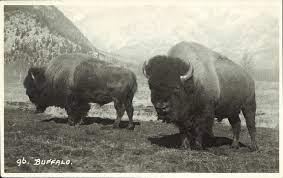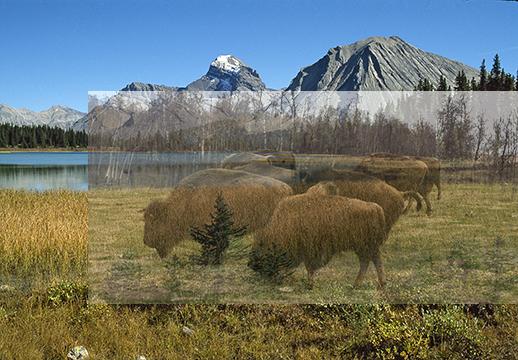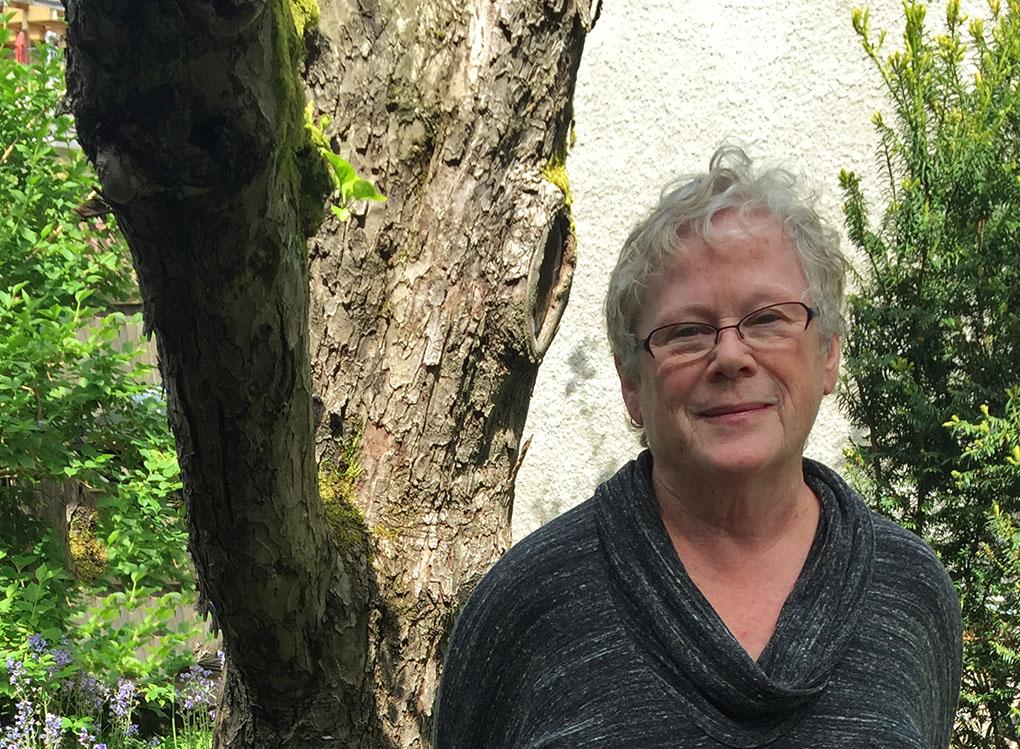Ribstone boulder petroglyphs near Viking, Alberta still receive offerings to Old Man Buffalo. Carole Harmon, 2008
THE BUFFALO: A Treaty of Co-operation, Renewal and Restoration
Bison, Buffalo, Iinni, Tatanga, Tatanka, Paskwâwimostos, Xaniti, Qwisp, Kamquq̓ukuǂ ʔiyamu, Iyanee
TREATY
Creator gave us many gifts and teachings to survive this world. One of those teachings is everything is interrelated. In the Indian practice, the interrelated world is realized through Treaty-making with all my relations.
The Buffalo Treaty is a cross-border agreement of co-operation among First Nations in Canada and the USA. It was first signed in Montana in 2014. Canadian signatories were added in 2015 in a ceremony at Buffalo Nations Luxton Museum in Banff in the Canadian Rockies. This endeavour was part of a plan to reintroduce buffalo into the wild in North America. In Canada the territory selected was several inter-connecting remote valleys in Banff National Park in the Canadian Rockies.
One summer day in 2017 I run into my old pal Charlie on Banff Avenue when I’m passing through Banff, a small town within Banff National Park in the Canadian Rockies. “Let’s get a coffee, Charlie,” I say taking his arm. In the old days we’d have gone to his hangout, Jeannie Eng’s Rundle Restaurant. Now the Rundle is gone and it’s a coffee shop on a side street away from the crowds. We shuffle through the line-up, exchanging gossip. “Charlie, what do you think of this proposed buffalo wilderness reserve in Panther Valley?”
Charlie replies in his typically direct manner. “To tell the truth I don’t rightly know what to think. It’s a hell of an idea but I don’t see how it’s gonna work.” (We’re discussing a wildly popular recent initiative of Parks Canada to re-introduce plains bison, or buffalo, into remote areas of Banff National Park.)
I persist. “Why wouldn’t it work? There have been buffalo in Elk Island and Wood Buffalo National Parks for ages. This seems like a great idea, to reintroduce them into the wild again.”
 Plains Bison, or Buffalo
Plains Bison, or Buffalo
vintage postcard, Byron Harmon Photos
Photograph by Byron Harmon, early twentieth century
Charlie leans back and puts his boots on a chair, settling in to educate me. “Here’s a little bit of history. In 1907 buffalo had their very own Buffalo National Park on Battle River near Wainwright, Alberta, right next to where they used to roam in the thousands. The government bought itself a herd of seven hundred buffalo from Flathead Indian Reserve in Montana to stock it since Canadian plains buffalo had already all been slaughtered. That herd kept growin’. Every year they had to shoot a bunch of buffalo to keep the herd within park boundaries. They closed the park down in 1940 and now it’s a military reserve.”
“So, you’re thinking the same thing will happen in Panther Valley,” I reply thoughtfully.
“Yup. Buffalo like ta breed and buffalo like ta roam.”
I protest, “They’ve built natural fences to keep them contained, and the herd will expand into Dormer and Cascade Valleys. That’s a lot of land.”
Charlie sighs, “Who’s gonna keep them buffalo from bustin’ out onto the prairie when the herd gets bigger? There could be lottsa buffalo again if we let ‘em free but I don’t expect them buffalo are gonna stay where they’re told.”
 Former Bison Motel in Wainwright Alberta
Former Bison Motel in Wainwright Alberta
photo Carole Harmon, 2008
I pull out my newspaper with Harvey Locke’s interview about the project. Harvey is a well- known environmental activist who has been backing this project. “Charlie, what do you think of this statement of Harvey’s in the Crag?”
It rights the historical wrong of the elimination of this magnificent animal. The return of bison to the landscape represents hope for nature and is an important step toward reconciliation with Indigenous people.
Charlie snorts. “I can’t see how one little herd in Panther Valley evens the score for seventy-five million buffalo slaughtered on the plains since the railway come, plus all the other insults done to the Indians as well. I hear say this scheme will cost six and a half million. Might be better to put buffalo on the Reserves.”
“You’ll appreciate this story, Charlie. I just finished reading Michael Crummey’s Sweetland. A character in his novel tells this true story. When Joey Smallwood was Premier his government tried to introduce buffalo into Newfoundland. The idea was to give them their own island so they would become a source of food for Newfoundlanders. They loaded two bulls and sixteen young cows into box cars in Alberta, shipped them across Canada, then barged them by schooner to Brunette Island in Fortune Bay off the coast. They moved people off Brunette Island to make way for those buffalo. A third of the buffalo died on the trip across Canada. The biggest bull tipped the barge crossing the bay and nearly drowned.”
Charlie snorts through tears of laughter, “Governments just can’t stop movin’ critters about”.
I hand Charlie a napkin then continue. “The first winter the buffalo wandered out on the cliffs to nibble the grass and lick salt off the rocks, slipped on the ice and toppled into the ocean. Their bones were found on the rocks in the spring.”
Charlie’s no longer laughing. “All of them died?”
“That’s right,” I reply. We focus on our coffee.
Charlie looks me in the eye. “Hell, I can’t rightly say why, but I’m riled up about buffalo these days. They been gone from the prairies so long you’d think no one’d care. Remember Banff Indian Days? Us kids’d ride our bikes to the Indian Grounds and play with the Indian kids. Exchanged our bikes for their horses. It were downright wrong of the government to kick Indians outa the National Parks.”
I remind him, “The Indian Grounds is on unceded land, it’s Stoney Nakoda land. You know, Charlie, there are little pockets of unceded land all through the mountain National Parks.”
 Dreaming of Buffalo in Bison Motel
Dreaming of Buffalo in Bison Motel
photo collage, Carole Harmon
Charlie scratches his head. “Hell, I wish them buffalo well. Indians too. No point in complainin’. Maybe they’ll let Indians back in the park next.” I finish my coffee. Charlie pays the bill.
“If there’s one thing don’t last forever it’s government policy.” Charlie tips his hat to me as he leaves.
___________________
In March 2018 my friend Sandra Semchuk invites me to go to Ottawa with her for the awards ceremony of the 2018 Governor General Awards for lifetime achievement in Visual and Media Arts. This is the highest honour an artist can receive in Canada. One of the other artists receiving this award is Sitsika artist Adrian Stimson. Old Man Buffalo is alive in the National Gallery of Canada where works of the awards winners are on display. “Beyond Redemption” by Adrian Stimpson welcomes and challenges viewers as they enter the gallery. Ten figures sit in circle—black crosses draped with dusty buffalo robes which look like elders sitting in council. The ‘campfire’ in the centre, which dominates the scene, is a spotlit stuffed buffalo standing on a red plastic mat.
Cliff White was Manager of Ecological Research and Restoration for Parks Canada from 1990-2009. His wide-ranging work included complex issues of how to mitigate harmful human interaction with the environment. Traditional First Nation practices played a large part in his thinking and the programs his team developed. He worked closely with indigenous elders and other stakeholder groups in developing the Bison Restoration Project, which was implemented in 2017. Now Scientist Emeritus, Parks Canada, and Senior Biologist for his own consulting firm, CW and Associates, Cliff White is Research Coordinator, Canadian Rockies Bison Initiative, working to maintain an interdisciplinary science-based approach to restoring bison to parks and protected areas along the western edge of historic bison range.
Whyte wrote in 2019, “The first hooves of a wild buffalo herd in over a century touched the ground in February 2017, as sixteen plains bison were air-lifted from their steel transportation containers. The newly reintroduced bison herd was held for over a year in a large ’soft-release’ pasture. Here they adjusted to the Rocky Mountain climate and vegetation conditions.
Meanwhile, in the surrounding valleys, Parks Canada’s staff burned several large areas near the holding pasture to provide a fresh crop of grass and herbs for the planned ‘get-out-of-jail’ date… July 29, 2018. The herd, now numbering thirty-one, walked through an open gate into their restored homeland. Within a day, they sought out freshly burned slopes and…ascended hundreds of feet nearly to tree-line while grazing on succulent new forage. By summer solstice of 2019, the herd was roaming across 300 square miles of Banff’s backcountry, reopening old trails and rolling in wallows that had lain dormant for over a century.”
Summer 2022. The herd has grown from less than twenty to around eighty-five or ninety animals since 2018. In 2021 a young male calf wandered onto provincial land and was put down, rather than returning it to the herd. Sixteen calves were born in 2022.
Parks Canada will produce a summary report on this five- year pilot project.
This is not the only buffalo re-wilding project in North America. Each faces the same challenge, how to confine a keystone species which could re-populate the plains of North America. Each faces conflicting needs and desires of different stakeholder groups.
 Imagining Buffalo in Red Deer Valley
Imagining Buffalo in Red Deer Valley
Photo collage, Carole Harmon
Cliff Whyte’s cousin was my friend, the poet, historian and environmentalist Jon Whyte, who died in 1992. Unlike Charlie, who is a fabrication based on several old-timers I was friends with when I lived in Banff, Jon was flesh-and-blood and larger-than-life in the small community of Banff where he was equal parts inspiration and gadfly.
I wonder what he would have made of the re-wilding project, so I ask him.
A diaphanous form quivers over Deception Pass near Skoki in the Canadian Rockies—the ghost of my friend, Jon Whyte, shivers into view. This was one of Jon’s favourite places. He came with family and friends, over and over, staying at Skoki Lodge.
Today Jon is on his way to rendezvous with another ghost. He skims carpets of golden avalanche lilies and tiny white spring beauty which bloom among snow patches and fill newly opened meadows. He glides along Skoki Creek, which meanders from its glacial source over smooth red and green stones, among larch trees which sprout tufts of spring green needles and minute red blossoms. He plunges down steep rapids through a gorge to Moose Meadow, then skirts Skoki Mountain to arrive at his rendezvous on the shore of Red Deer Lake.
 Sir Donald, Last of the Wild Plains Buffalo
Sir Donald, Last of the Wild Plains Buffalo
vintage postcard from hand-coloured print, early twentieth century
A shiver in the air interrupts the peaceful scene in Red Deer Valley. The massive form of a ghost buffalo wavers along the shoreline, stopping to admire plentiful tufts of grasses it can no longer graze. Massive Sir Donald, the last plains bison in North America to be born in the wild, shudders to a stop before Jon.
“Sir Donald,” Jon’s ghost greets him.
“Jon Whyte,” the ghost buffalo replies.
Sir Donald was born near Battleford, Saskatchewan in the wild. Before he was named for his purchaser, Sir Donald Smith, Lord Strathcona, this buffalo had already spent most of his life in captivity. Lord Strathcona purchased, then donated, the massive bull to Canada’s first conservation herd of plains buffalo which was established in Banff National Park in 1897.
Sir Donald died in captivity in the 300- acre ‘Buffalo Paddock’ in Banff National Park in 1909, first ostracized from the herd, then gored to death by younger bulls
“I wasn’t sure if my proposal would interest you,” Jon says to Sir Donald.
Sir Donald ponders his reply. “Did you know I was living in a penitentiary near Battleford when Lord Strathcona bought me? I was the last wild plains buffalo but I died in captivity in a national park. Don’t you find that ironic? It’s a romantic idea, releasing buffalo in the mountains, but valleys are corrals, mountains fences. You don’t mention any plans to return buffalo to the plains.”
“The valleys connect,” Jon reassures him. “This valley is a good example—it’s not in the management plan for the herd but buffalo would love living here.”
Grass shimmers as Sir Donald hoofs the earth in thought. “Buffalo aren’t naturally rebellious, they have to be led, or provoked,” he muses.
“That’s why I summoned you,” urges Jon. “You experienced life in the wild and captivity. What better spirit to guide the herd?”
Sir Donald looks long and hard at Jon. His phantom eyes seem to look left and right and yet Jon feels them drill through him. “What’s in it for you, Jon Whyte?”
About the Author

Carole Harmon writes as she photographs—from islands of memory and awareness. She grew up in Banff, in the Canadian Rockies, where she spent much of her adulthood as a landscape photographer and regional publisher continuing a family business begun in 1904 by her paternal grandfather, Byron Harmon.
Now she lives on the Sunshine Coast, BC, where she co-produces, with Ingrid Rose and Gary Sill, an internet radio program and podcast which broadcasts internationally—Writers Radio.She has been actor, photographer, writer, business woman who responds to the world through whatever medium she’s using. She works with cascades of images given to her by family, other creatures, landscapes, world.
Her essay “In Mountain Light, Walking With My Grandfather” is in the anthology Whiteness is Not an Ancestor, Essays on Life and Lineage by white Women, Center for Ancestral Blueprints Publishing, 2020, Lisa Iversen, editor. Her essay “Secrets Breed Questions” is included in the forthcoming anthology Don’t Tell: Family Secrets, Demeter Press, 2023, Donna McCart Sharkey and Arleen Paré, editors.
caroleharmon.ca | writersradio.ca | byronharmonphotos.com
Return to top